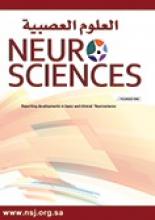To the Editor
With reference to the interesting case report by Lardhi,1 Jones criteria have been modified throughout the years, most recently in 19922 to aid clinicians in the diagnosis of initial attacks of acute rheumatic fever (RF), and to minimize over diagnosis of the disease. Diagnosis of acute RF is based on the presence of documented preceding group A streptococcal infection (GASI), in addition to the presence of 2 major manifestations, or one major, and 2 minor manifestations of the Jones criteria. Major manifestations include carditis, polyarthritis, erythema marginatum, Sydenham chorea, and subcutaneous nodules. Minor manifestations include arthralgia, fever, previous episode of rheumatic fever, or inactive heart disease, and laboratory findings of elevated erythrocyte sedimentation rate, C-reactive protein, leukocytosis, and prolonged PR interval on electrocardiography. Without documentation of antecedent GASI, the diagnosis of RF is much less likely except in a few rare scenarios.3 Interestingly, Lardhi1 reached a diagnosis of RF in their studied child based on one major criterion (chorea) without concomitant evidence of antecedent GASI. Apart from increasing alertness of practicing pediatricians that the diagnosis of Sydenham chorea should always be considered in young children with choreiform movements, I presume that Lardhi’s1 case report sends another important sound message to the practicing pediatricians. It is that Jones criteria are guidelines to assist the treating pediatricians and should not be substituted for clinical judgment as strictly following these guidelines with compulsory documentation of a previous GASI might result in the under diagnosis of RF. In an interesting Brazilian study4 recruiting a cohort of RF patients, only 29.6% patients fulfilled Jones criteria for RF necessitating an evidence of antecedent GASI, but when compulsory GASI was disregarded, the number significantly skipped to 87.7% patients (p<0.0001).
Reply from the Author
I greatly thank Professor Al-Mendalawi for his interest in my recently published article.1 The presence of 2 major criteria, or one major and 2 minor criteria plus evidence of antecedent group A beta hemolytic streptococcus infection (GBSI) indicates high probability of acute RF. However, the diagnosis of RF is acceptable without 2 major or one major and 2 minor criteria, and without evidence of preceded GBSI under the following 2 conditions: 1) Chorea when other causes have been ruled out. 2) Insidious or late onset carditis with no other explanation.2 I agree with Professor Al-Mendalawi that Jones criteria are guidelines for the diagnosis of RF. Practicing pediatricians should not substitute these guidelines for clinical impression, particularly in situations where evidence of preceded GBSI is lacking.5
Amer A. Lardhi
Department of Pediatrics, King Fahad Hospital of the University, Al-Khobar, Kingdom of Saudi Arabia
- Copyright: © Neurosciences
Neurosciences is an Open Access journal and articles published are distributed under the terms of the Creative Commons Attribution-NonCommercial License (CC BY-NC). Readers may copy, distribute, and display the work for non-commercial purposes with the proper citation of the original work.






